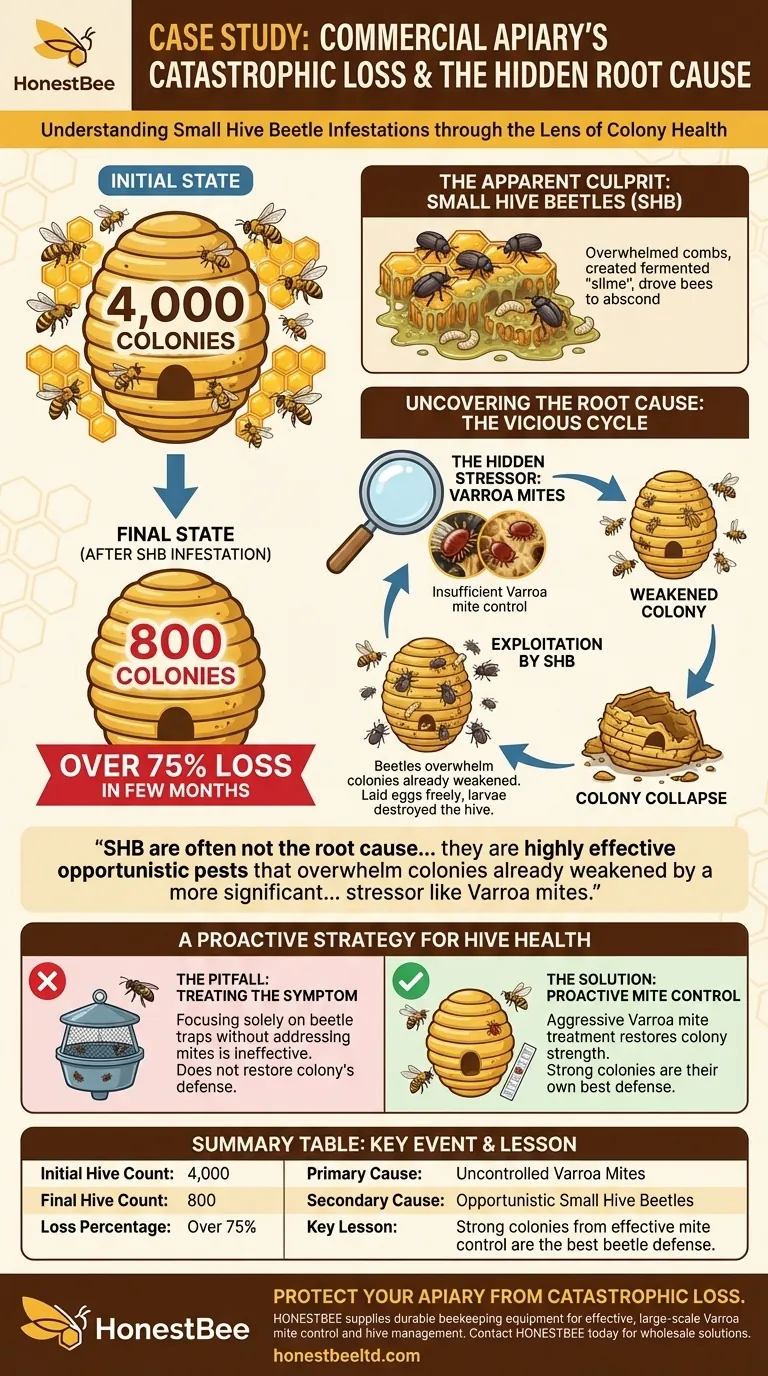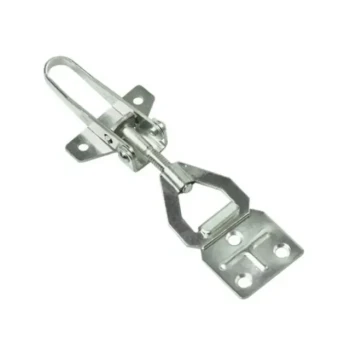In one commercial apiary's experience, a small hive beetle infestation led to a catastrophic loss of over 3,200 hives in just a few months. This reduced their 4,000-hive operation by more than 75%, demonstrating how quickly this pest can devastate an apiary when underlying conditions are not managed.
The crucial lesson from this collapse is that small hive beetles (SHB) are often not the root cause of a hive's failure. Instead, they are highly effective opportunistic pests that overwhelm colonies already weakened by a more significant, and often less visible, stressor like Varroa mites.

The Anatomy of a Colony Collapse
A large-scale loss provides a clear, if painful, lesson in the dynamics of hive pests. The speed and scale of this event highlight how one problem can cascade into another.
The Initial Scale
The apiary in question was a significant commercial operation, managing a total of 4,000 honey bee colonies. This scale is important, as it shows that even experienced, large-scale beekeepers are vulnerable.
The Devastating Loss
Within a few short months, the operation was reduced from 4,000 hives to just 800. This represents a loss of over 75% of their colonies and production capacity.
The Apparent Culprit
The direct cause of the hives failing was the small hive beetle. The beetles and their larvae overwhelmed the combs, creating a fermented "slime" that drove the remaining bees to abscond, destroying the colony.
Identifying the Root Cause, Not Just the Symptom
While beetles were the final executioner, they were not the primary problem. The apiary's recovery and subsequent stability revealed the true underlying issue that allowed the beetles to gain a foothold.
The Hidden Stressor: Varroa Mites
The apiary discovered that their true vulnerability was an insufficient focus on Varroa mite control. Varroa mites weaken colonies by feeding on bees, transmitting viruses, and shortening their lifespans.
The Vicious Cycle
A hive weakened by a high mite load cannot maintain a strong enough population to effectively police its own hive. Healthy, populous colonies can trap and remove beetles, but a dwindling, sick workforce cannot.
The Beetle Takeover
The small hive beetles exploited this weakness. With no bees to stop them, they laid eggs freely, and their larvae quickly consumed pollen and honey, ultimately destroying the hive. The beetle infestation was a symptom of a deeper colony health crisis.
The Pitfall of Misdirected Treatment
This experience underscores a critical principle in integrated pest management for beekeeping. Focusing solely on the most visible pest can lead to disaster if the foundational issue is ignored.
Treating the Symptom
Simply setting beetle traps without addressing the mite problem would have been an incomplete and ineffective strategy. It would not have restored the colony's own ability to defend itself.
The Power of Proactive Mite Control
After this devastating loss, the apiary shifted its primary focus to aggressive and effective Varroa mite treatment. By keeping mite loads low, the colonies remained strong and populous.
A New Stability
With their health restored, the hives were once again capable of managing beetle populations on their own. The apiary now rarely loses a hive to small hive beetles because the root cause of their vulnerability has been eliminated.
A Proactive Strategy for Hive Health
This case study provides a clear directive for beekeepers of any scale. To prevent a small hive beetle disaster, you must look beyond the beetles themselves.
- If your primary focus is preventing a catastrophic SHB infestation: Make vigilant, consistent, and effective Varroa mite control your absolute number one priority.
- If your primary focus is managing an existing beetle problem: Use traps as a secondary control measure, but immediately assess and aggressively treat the underlying Varroa mite load to restore the colony's strength.
Ultimately, a strong, healthy, and populous bee colony is its own best defense against most secondary pests.
Summary Table:
| Key Event | Impact on the Apiary |
|---|---|
| Initial Hive Count | 4,000 colonies |
| Final Hive Count | 800 colonies |
| Loss Percentage | Over 75% |
| Primary Cause | Uncontrolled Varroa mite infestation |
| Secondary Cause | Opportunistic small hive beetle takeover |
| Key Lesson | Strong colonies from effective mite control are the best beetle defense |
Protect Your Apiary from Catastrophic Loss
Don't let your operation be the next cautionary tale. The experience of this commercial apiary proves that a strong, healthy colony is its own best defense. HONESTBEE supplies the durable beekeeping supplies and equipment that commercial apiaries and distributors rely on for effective, large-scale Varroa mite control and hive management.
Contact HONESTBEE today to discuss wholesale solutions that will fortify your hives and secure your bottom line.
Visual Guide

Related Products
- Removable Washable Hive Beetle Trap Attractants for Small Hive Beetles
- Wholesales Dadant Size Wooden Bee Hives for Beekeeping
- Automatic Honey Flow Beehive 4 Frame Mini Hive for Beekeeping
- Heavy Duty Adjustable Hive Connector
- Honey Flow Garden Bee Hive Flow Hive Best Beehive for Beginners
People Also Ask
- What are the chemical-free options for trapping hive beetles? Control Pests Without Chemicals
- How should filled beetle traps be handled? Safely Remove and Dispose to Protect Your Hive
- What should be done if a hive shows signs of a small hive beetle infestation? Protect Your Hive Now
- What is the recommended number of beetle traps per hive? Optimize Your Hive's Beetle Defense
- How do beetle blasters work to protect bee colonies? Effective IPM for Healthy Hives



















